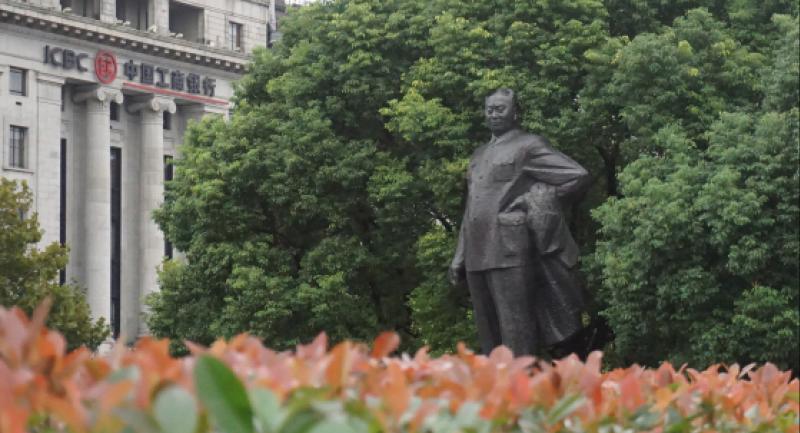Wonders on the waterfront

A stroll along the Bund area of Shanghai is the best way to take in the juxtaposition of futuristic skyscrapers and colonial-era buildings.
Shanghai is probably Asia’s greatest man-made phenomenon. Once a small fishing village in Central China’s coastal district, the city was romanticised as the opium den of Asia when the Europeans arrived with gunships and the drug in the early 20th Century. They left behind them the neo-classical and Art Deco buildings that still line the west bank of the Huangpu River and today these old grandes dames stand in direct contrast to the architecturally distinctive and often eccentric futuristic skyscrapers that dominate the Bund business area.
The best way to experience the massive changes that have taken place over the past several years is to stroll along the waterfront promenade on the west bank. Here, on both sides of the river, the past and future – old money and new money – are entwined like the dragon and swan in Chinese mythology.
North of the Bund, where Suzhou Creek meets the Huangpu River, is the best place to start a walk through history. With Waibaidu Bridge presiding over the creek, the Broadway Mansions, Russian Consulate, Astor House Hotel, Union Church and former British Consulate form a tight cluster. The British, the Russians, the priests and the “tourists” must have made for a fascinating community back in the early 20th Century.
Built as an exclusive residential hotel by the British in the early 1930s, the Broadway Mansions is a testament to the art deco movement of the day. It survived the Sino-Japanese War and the Culture Revolution apparently because everyone loved its glamorous character. Japanese troops seized the Mansions in 1937 for use as the headquarters of the Japanese Army Liaison Office.
After World War II, the Shanghai Municipal Council assumed ownership of the building and leased part of it to the Foreign Correspondents’ Club of China, leading American journalist John Robinson Beal to quip that it was the most decorous press club in Asia. The Chinese Civil War might have been raging in the rural areas just outside Shanghai but inside the Mansions, there was dancing. Journalists, black market speculators, military personnel and their mistresses partied heavily in its bar almost every night.
The Mansions is still a glamorous place, especially to the Shanghainese and has become the popular backdrop for wedding photography, with numerous brides and grooms posing in front of the iron bridge of Waibaidu.
From the Northern corner of the Bund, I keep strolling southwards, passing the Jardine Matheson and Old Bank of China buildings before reaching my destination – the Bund 18, one of the key landmarks of the British Concession. Established in 1932, it was Shanghai’s first capital bank.
The building housed the Shanghai headquarters of what became Standard Chartered Bank and in 2006 was recognised by Unesco in the Asia-Pacific Awards for Cultural Heritage Conservation. Today the heritage building is home to designer shops, upmarket art galleries and fine-dining establishments.
Next door to the Bund 18 is the North China Daily News Building, the tallest of the heritage buildings and once the publishing house of the most influential English-language newspaper in Shanghai. Ironically, an influential press wasn’t in the plans of the Communist Party when it was building the new China. The North China Daily News suspended publication at the orders of the Party and the building was seized by the Shanghai municipal government before being rented out to an insurance company, which still occupies it today. Media fans will appreciate the classic facade with its bas relief carvings depicting the symbols for art, science, literature, commerce and truth.
From the East of Zhongshan Road, where all the heritage buildings stand, I cross the road to the west bank of the Huangpu River, where the waterfront promenade stretches from North to South.
It is a place to mingle and observe. The Chinese tourists roam around with smartphones and selfie sticks trying to take perfect self-portraits. Western tourists, on the other hand, take a serious look at the Bund and the line of heritage buildings before shifting their attention to the modern futuristic metropolis across the river. Tourist cruises and cargo ships come and go along the river. I sit on a bench and watch the world going by on the Huangpu River and the clouds drifting through the tips of Shanghai Tower and the city’s skyline.
Standing 623 metres tall, Shanghai Tower twists like a DNA model into the sky. The building makes a strong statement for this financial powerhouse of China. It held the record for the world’s tallest building before being surpassed by Dubai’s Burj Khalifa, which stands 829.8 metres tall. However, the Shanghai Tower is still top of the rankings for highest observation deck.
In the evening I line up with other tourists to take the world’s fastest elevator to the 123rd floor. With a speed of 65 kilometres per hour (and severe ear-popping), I arrive at the observation deck and see, well, nothing. The clouds are so dense that they are blocking all the buildings below.
I retrace my steps along the Bund as night falls, eager to see “old Shanghai”. The opium dens have gone, of course, but the exotic debauchery left behind is better still.
At the Hakkasan, a fine-dining restaurant in the Bund 18, a light saxophone sound permeates the air. Two Western women are sitting at the long bar, cigarettes in hand, looking at the glowing Shanghai Tower. The Chinese waiters and waitresses are busy pouring chilled Moet for a group of corporate types. A trip in the elevator from Hakkasan takes me to Bar Rough. Shanghai’s high-end club favoured by celebrities and VIPs.
If that John Robinson Beal could see the Bund 18 today, he would probably surmise that Shanghai really hasn’t changed at all.
IF YOU GO
